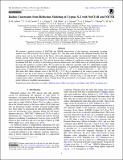Radius Constraints from Reflection Modeling of Cygnus X-2 with NuSTAR and NICER
Author(s)
Ludlam, RM; Cackett, EM; García, JA; Miller, JM; Stevens, AL; Fabian, AC; Homan, J; Ng, M; Guillot, S; Buisson, DJK; Chakrabarty, D; ... Show more Show less
DownloadPublished version (5.095Mb)
Publisher with Creative Commons License
Publisher with Creative Commons License
Creative Commons Attribution
Terms of use
Metadata
Show full item recordAbstract
We present a spectral analysis of NuSTAR and NICER observations of the luminous, persistently accreting
neutron star (NS) low-mass X-ray binary Cygnus X-2. The data were divided into different branches that the
source traces out on the Z-track of the X-ray color–color diagram; namely, the horizontal branch, the normal
branch, and the vertex between the two. The X-ray continuum spectrum was modeled in two different ways that
produced comparable quality fits. The spectra showed clear evidence of a reflection component in the form of a
broadened Fe K line, as well as a lower-energy emission feature near 1 keV likely due to an ionized plasma located
far from the innermost accretion disk. We account for the reflection spectrum with two independent models
(RELXILLNS and RDBLUR*
RFXCONV). The inferred inclination is in agreement with earlier estimates from optical
observations of ellipsoidal lightcurve modeling (RELXILLNS: i = 67° ± 4°; RDBLUR*
RFXCONV: i = 60° ± 10°).
The inner disk radius remains close to the NS (Rin 1.15 RISCO) regardless of the source position along the
Z-track or how the 1 keV feature is modeled. Given the optically determined NS mass of 1.71 ± 0.21 Me, this
corresponds to a conservative upper limit of Rin 19.5 km for M = 1.92 Me or Rin 15.3 km for M = 1.5 Me. We
compare these radius constraints to those obtained from NS gravitational wave merger events and recent NICER
pulsar lightcurve modeling measurements.
Date issued
2022-03-01Department
MIT Kavli Institute for Astrophysics and Space ResearchJournal
The Astrophysical Journal
Publisher
American Astronomical Society
Citation
Ludlam, RM, Cackett, EM, García, JA, Miller, JM, Stevens, AL et al. 2022. "Radius Constraints from Reflection Modeling of Cygnus X-2 with NuSTAR and NICER." The Astrophysical Journal, 927 (1).
Version: Final published version